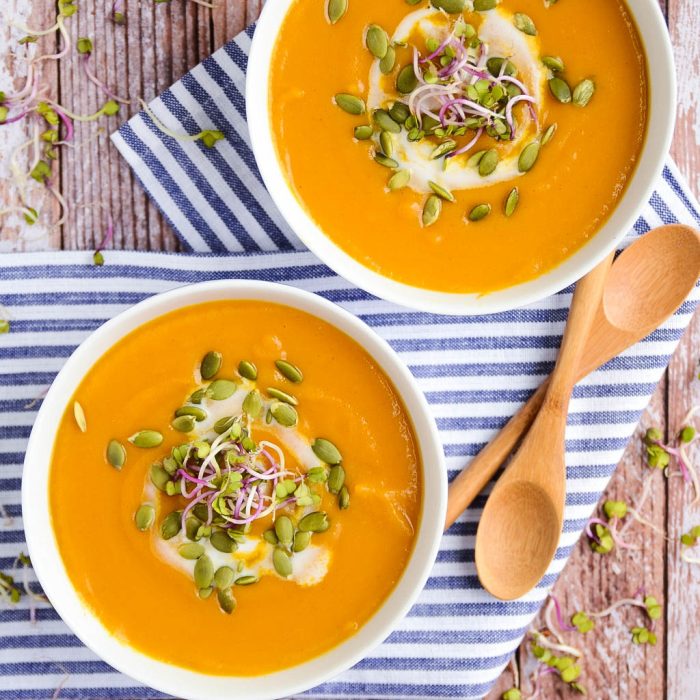Butternut Sweet Potato Soup Recipe Variations
Butternut sweet potato soup recipe – This recipe offers a versatile base for creating a variety of delicious and nutritious butternut sweet potato soups. We’ll explore several variations, focusing on different spice levels, vegetable additions, protein enhancements, and cooking methods.
A creamy butternut sweet potato soup is a comforting classic, perfect for a chilly evening. If you enjoy hearty soups, you might also appreciate the depth of flavor in an equally satisfying award winning chicken noodle soup recipe ; both recipes offer rich textures and satisfying warmth. Returning to the butternut sweet potato soup, remember to roast the vegetables for maximum sweetness before blending for a truly exceptional bowl.
Spice Level Variations
Adjusting the spice level allows you to cater the soup to individual preferences. Here are three variations: mild, medium, and spicy.
- Mild: The base recipe (detailed in the introduction) provides a naturally sweet and mild flavor. For an even milder version, omit the cayenne pepper entirely.
- Medium: Add 1/4 teaspoon of cayenne pepper to the base recipe for a subtle warmth. A pinch of smoked paprika also enhances the depth of flavor without adding significant heat.
- Spicy: Increase the cayenne pepper to 1/2 teaspoon, or even add a small, finely chopped jalapeño pepper for a noticeable kick. A dash of chipotle powder can provide a smoky heat.
Vegetable Variations
Adding other vegetables expands the flavor profile and nutritional value of the soup. This variation incorporates carrots and parsnips.
Adding approximately one cup each of diced carrots and parsnips to the base recipe will create a richer, earthier flavor profile. The carrots contribute sweetness, while the parsnips add a slightly nutty note. This variation retains the creamy texture of the original recipe but with added depth and complexity.
Bean and Lentil Variations, Butternut sweet potato soup recipe
Incorporating beans or lentils significantly boosts the protein and fiber content of the soup, making it a more substantial and nutritious meal.
- Black beans: Adding one cup of cooked black beans will impart a slightly earthy and smoky flavor, along with a hearty texture. This adds significant fiber and protein.
- Red lentils: One cup of red lentils, cooked until tender, will create a creamier soup with a subtle, nutty flavor. Red lentils are particularly high in protein and iron.
- Cannellini beans: One cup of cannellini beans provides a creamy texture and a mild, slightly sweet flavor that complements the butternut squash and sweet potato. This adds protein and fiber.
Cooking Methods and Techniques
This section details two common methods for preparing the soup: stovetop and slow cooker, highlighting their advantages and disadvantages.
Stovetop vs. Slow Cooker Methods
Both stovetop and slow cooker methods yield delicious results, but each has its own benefits and drawbacks.
| Method | Advantages | Disadvantages | Time |
|---|---|---|---|
| Stovetop | Faster cooking time, more control over the cooking process. | Requires more hands-on attention. | 45-60 minutes |
| Slow Cooker | Minimal supervision required, allows for hands-off cooking. | Longer cooking time, less control over the cooking process. | 6-8 hours on low, 3-4 hours on high |
Roasting Butternut Squash and Sweet Potatoes
Roasting the vegetables before adding them to the soup intensifies their natural sweetness and creates a deeper, more complex flavor. It also improves the texture, resulting in a smoother, richer soup.
- Preheat oven to 400°F (200°C).
- Peel, deseed, and cube butternut squash and sweet potatoes into approximately 1-inch pieces.
- Toss the vegetables with 2 tablespoons of olive oil, salt, and pepper.
- Spread the vegetables in a single layer on a baking sheet.
- Roast for 30-40 minutes, or until tender and slightly caramelized.
Liquid Variations

Source: blissfulbasil.com
The choice of liquid significantly impacts the soup’s flavor and texture. Here’s a comparison of vegetable broth, chicken broth, and coconut milk.
| Liquid | Texture | Flavor | Notes |
|---|---|---|---|
| Vegetable Broth | Light and slightly thinner | Savory and subtly vegetal | A classic choice that enhances the natural flavors of the vegetables. |
| Chicken Broth | Similar to vegetable broth | Adds a richer, more savory flavor | Provides a deeper umami taste, suitable for those who enjoy a heartier broth. |
| Coconut Milk | Creamier and thicker | Adds a creamy sweetness and subtle coconut flavor | Creates a richer, more indulgent soup, perfect for a special occasion. |
Serving Suggestions and Garnishes

Source: hungryhealthyhappy.com
Elevating the presentation and flavor of the soup with thoughtful serving suggestions and garnishes enhances the overall dining experience.
Serving Suggestions
- Pair with crusty bread for dipping.
- Serve as a starter before a lighter main course, such as a salad.
- Enjoy it as a comforting and satisfying main course, especially on a cold evening.
Garnish Options
Garnishes not only enhance the visual appeal but also add layers of flavor and texture.
- Toasted pumpkin seeds: Adds a crunchy texture and nutty flavor that complements the sweetness of the soup.
- Fresh cilantro: Provides a bright, herbaceous note that cuts through the richness of the soup.
- A swirl of coconut cream: Adds a luxurious touch and enhances the creamy texture.
Garnish Texture Categories
Categorizing garnishes by texture helps in creating a balanced and visually appealing presentation.
- Crunchy: Toasted pepitas, croutons, chopped nuts
- Creamy: Crème fraîche, coconut cream, a dollop of yogurt
- Fresh: Chopped chives, parsley, cilantro
Nutritional Information and Health Benefits: Butternut Sweet Potato Soup Recipe

Source: yummynoises.com
Butternut squash and sweet potatoes are nutritional powerhouses, packed with essential vitamins, minerals, and antioxidants. This section details their health benefits and how to adapt the recipe for various dietary needs.
Nutritional Benefits
Butternut squash and sweet potatoes are excellent sources of Vitamin A (in the form of beta-carotene), Vitamin C, potassium, and fiber. They are also rich in antioxidants, which help protect against cell damage.
Dietary Adaptations
This recipe can easily be adapted to accommodate various dietary restrictions.
- Vegan: Ensure the broth used is vegetable-based and avoid any dairy-based garnishes.
- Gluten-free: Use gluten-free bread for dipping, if applicable.
- Dairy-free: Omit any dairy-based garnishes and use a plant-based milk alternative (like coconut milk) for a creamier consistency if desired.
Nutritional Information (per serving, approximate)
| Nutrient | Amount | Unit | % Daily Value* |
|---|---|---|---|
| Calories | 250-300 | kcal | ~12-15% |
| Fat | 5-7 | g | ~7-10% |
| Protein | 5-7 | g | ~10-14% |
| Carbohydrates | 40-50 | g | ~13-17% |
*Percent Daily Values are based on a 2,000 calorie diet.
Visual Presentation and Photography
The visual presentation of the soup plays a significant role in enhancing the dining experience. This section focuses on creating a visually appealing dish and photograph.
Ideal Visual Presentation
Serve the soup in a rustic bowl, preferably a warm color like terracotta or cream. The vibrant orange color of the soup should be the focal point. A smooth, creamy texture is desirable, with no visible chunks of uncooked vegetables. The garnishes should be strategically placed to add visual interest without overwhelming the soup’s color.
Visually Appealing Photograph
The photograph should capture the soup’s warmth and richness. Use soft, natural light to highlight the soup’s color and texture. The composition should be simple and elegant, perhaps with a few strategically placed garnishes and a piece of crusty bread in the background. The overall mood should be inviting and comforting, conveying the soup’s deliciousness.
Tips for Enhancing Visual Appeal
Using a shallow bowl showcases the soup’s color and texture. Consider using a contrasting color for the bowl or placemat to make the soup stand out. Neatly arranged garnishes add a touch of elegance. Avoid overcrowding the bowl; allow the soup to be the star.
Popular Questions
Can I freeze this soup?
Yes, this soup freezes well. Allow it to cool completely before storing in airtight containers for up to three months.
What if I don’t have butternut squash?
You can substitute with other winter squashes like kabocha or acorn squash, though the flavor profile might differ slightly.
How can I make it creamier?
Adding a dollop of coconut cream or a splash of heavy cream before serving will increase creaminess.
Can I use canned sweet potatoes?
Yes, canned sweet potatoes can be used as a convenient substitute, but roasting fresh ones enhances the flavor.
